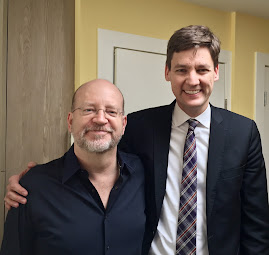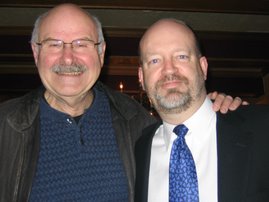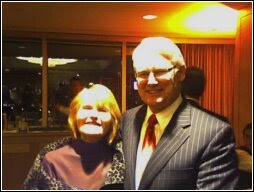Complicated STV takes away MLA accountability
By Bill Tieleman, Special to the Vancouver Sun
May 5, 2009
British Columbians are faced with an even more important decision than who to vote for in the May 12 election -- because a referendum on electoral systems could have far more long-lasting effects on our province.
Voters must choose between our existing first-past-the-post electoral system and a proposed Single Transferable Vote.
No STV, the official opponent group, has been strongly urging British Columbians to reject this complex, obscure and confusing electoral system that would take away the local accountability and responsibility members of the legislative assembly owe to voters.
The reasons are many.
STV would create enormous ridings of up to seven MLAs and 350,000 people that would take away local accountability and responsibility of MLAs to voters.
British Columbia's 85 single-member ridings would shrink to just 20 under STV, meaning instead of having your own MLA in your current riding, you would have up to seven MLAs in a much bigger area.
In some cases that new STV riding is absurdly large -- Cariboo-Thompson STV riding would stretch from Quesnel all the way to the United States border!
And in other cases the STV ridings simply make no sense.
The proposed North Island-South Coast STV riding is bisected by Georgia Strait.
Voters in Sechelt, Gibsons, Powell River and the Sunshine Coast would share their MLAs with those in Tofino, Port Alberni, Port Hardy, Comox, Courtenay and other north Island communities.
Imagine the all-candidates meetings or party nominations -- or imagine how the riding's four MLAs would rationally divide their attention to the more than 200,000 people there stretching across the strait and hundreds of kilometres apart.
No longer would any of these ridings have their own MLA. Instead, voters would have a group of MLAs, none of whom would be responsible for any of the former single member ridings.
Nor would there be any guarantee of where MLA offices and staff would be located to deal with residents' issues.
And instead of local accountability, voters would get "government by committee" with a group of MLAs who may not come from parts of the riding or get along with other elected members.
Then there's STV's complicated "fractionalizing" of your vote using a mathematical "transfer value" formula that means you will never know where your vote really went.
The "weighted Gregory inclusive method" is how votes will be chopped up.
Here's just a partial sample of how the vote works, as described by the Citizens Assembly that recommended STV:
"If a candidate on the first count gains more than the minimum number of votes needed to be elected, the candidate is declared elected, and the number of votes in excess of the number of votes needed to be elected (the surplus) is recorded.
"All of the elected candidate's ballots are then re-examined and assigned to candidates not yet elected according to the second preferences marked on the ballots of those who gave a first preference vote to the elected candidate. These votes are allocated according to a 'transfer value.'
"The formula for the transfer value is . . . ."
There are 11 other steps involved in the count. And after that, the "Droop Quota" will determine how many votes a candidate needs to win election.
I am not making this up.
STV proponents say you can easily rank your choices 1,2,3 -- but the math involved shows you will have no idea what happened to your vote because there are far more mathematical combinations possible than there are 6/49 Lottery pick possibilities.
STV will also increase, not decrease, the power of political parties.
Candidates in large STV ridings would have to reach far more voters in a 350,000-person STV riding than under our current system with single member constituencies of about 50,000 people.
That makes candidates even more dependent on political parties to get their names and message out.
And smaller third parties and independents would face huge challenges trying to reach that many voters across large geographic areas.
Malta under STV has failed to elect a single third party candidate since the 1960s and no independent since the 1950s.
And Ireland, the only other country using STV as a national electoral system, features politics far nastier and more party-dominated than here.
Lastly, if STV proponents are correct, B.C. could have perpetual unstable minority and coalition governments -- a recipe for endless backroom deals between politicians and no leadership for our province.
Remember that if STV passes, B.C. will be stuck with it for a recommended minimum of three elections -- that's 12 years, running to 2025 -- before changes can be considered.
Vote to keep our current first-past-the-post system on May 12 -- and if you believe there are better systems work for that afterwards. Don't accept a disastrous STV system that won't serve British Columbia.
For more information: www.nostv.org
Bill Tieleman is president of No STV.
Subscribe to:
Post Comments (Atom)





























11 comments:
It`s called big momentum.....
The latest election prediction from---Election predictor...
NDP 38 seats--Libs 40 seats--7 seats too close too call...
http://www.electionprediction.org/2009_bc/index.php
According to your NO-STV website:
"Voting with BC-STV is like ordering a steak and a beer but your neighbour determines the size of the steak and whether you get a pint or a glass."
Anyone who has taken the time to look at how STV actually works will marvel that a simple formula can produce such a fair result. In your example you get what you ordered (what a novel idea), but the portion is a little smaller because your needs are naturally balanced against everybody else's.
With our current system we keep ordering beer and steak but instead, we are fed a steady diet of monkey brains. Or perhaps we are so sick of monkey brains that we vote for spam instead (which nobody wants) because anything is better than monkey brains.
Your disinformation campaign is beneath contempt. By painting the system as "complicated" you are praying on the under-informed and the easily-confused. Like our current FPTP electoral system, you are pandering to the lowest common denominator.
What you fail to recognize is that STV benefits everyone equally. Those who are incapable of comprehending basic math are much better off than they were under FPTP. While they may not understand the formula, they still benefit from its inherent fairness.
Also from the NO STV website:
"Your second preference could get counted as 10% of a vote while your neighboour's second preference could get counted as a full vote, as some value in between, or not at all. With BC-STV you cannot control what fraction of your vote is given to each of your preferences because how your vote is counted is determined by how other people vote."
What a red herring! It doesn't matter "which percentage of your vote is given to which candidate". This is completely irrelevant towards achieving a fair result. The key point is that your entire vote goes towards electing someone with the highest weight given to your most preferred candidate. Every vote is counted equally. The total weight given to your vote is 100% - in accordance with the choices that you made.
"If this sounds confusing it is, and no one should vote for BC-STV without understanding how the count works."
False. It only sounds confusing because you are deliberately sowing confusion. Apart from your obfuscation, the process itself is not inherently confusing. The citizens assembly on electoral reform was randomly chosen, comprising people from all walks of life. If they didn't find STV confusing then why would ordinary British Columbians? Are you seriously suggesting that we should reject an inherently fair system because British Columbians are too stupid to understand grade school math?
Your claim to support MMPR is also deceptive since this option is not currently on the table. The citizens assembly on electoral reform studied electoral systems around the world for an entire year. This truly democratic process led to STV as the proposed alternative to the ridiculous FPTP system we are currently suffering under.
We may argue over whether or not STV represents the best possible system - perhaps it does not. However, it cannot be denied that it represents a huge leap in the right direction. Your campaign does not raise any legitimate concerns. All it does is foster irrational fear amongst the least informed segment of society - this would be the 35% of British Columbians who (according to your Ipsos Reid Poll) claim to know very little about our current FPTP electoral system! Shame on you.
A vote against STV is not a vote for MMPR - it is a vote for the status quo and for the continuation of corrupt, unaccountable, incompetent non- representative government.
The STV is not going to fly Bill. I notice people like Christie Clark claiming it's the way to go. Her message went around to many pro STV folk. So what's in it for folks such as her? Of course the greens sidle up to it as a posible way to sometime down the road actually get elected. The green in my riding appears to support the sale of crack cocaine. My God, she is the green leader, big STV supporter, and her signs are cuddling up to the STV signs on vacant lots, closed gas stations in our area of the village of Victoria. It's sad in a way as the Citizens Forum people can actually come up with good reasons to support their choice op a system and in my view would have been better debaters on the so called benfits of it all than the two guys I watched on TV stumbling along. And all the time really big issues on the election campaign are being shunted aside. My MP, who I like, has a different opinion than I do, and that's fair enough. My vote is as big as her's.
I go tomorrow to vote for my new redesigned riding, MLA. Hell I figure I'd rather not jump into a system that claim to fame is, if we don't like it, we could try again after three more elections. Not a great reason to vote for a system.
You and David have done a much better job explaining "No" than the opposite group who want us to jump into a system not often used to in the parts of the world where folks actually get to vote.
Public debate is always healthy.
Many serious issues exist in this province so lets focus on who gets to gain if King Gordo gets to become Saint Gordo, and who gets to do without. Polls open at 0:800 tomorrow and I'll be there to vote against a sytem though well meaning simply won't fly. I do feel a bit sad for the Citizen Forum folk who worked hard to sell a dead horse, and were bring used by some candidates who aspire to elected office.
Thanks MichealHey
I'm so tired of reading the scare tactics put forth by this blogger.
I have rarely encountered such a one-sided .. *and as much as I loathe the word it's appropriate here* hysterical response in lieu of a reasoned balanced presentation of the facts.
you should read Prof Pilon of the Univ of Victoria. He is much more informed on this issue... he puts forth a strong argument for YES to STV!
I see 5 comments so far, 1 "undecided" on STV, just talking about possible election results. But let's look at the more important ballot's comments. 1 No, 3 Yes. I'll do the math for you Bill because I know how complicated you find that. It's 75%, no wait it just went up to 80% with my comment, another Yes.
Of course it doesn't mean much, it's just a sample of the population, like the other polls that are out at this time. I do know from my time on the street talking to people that almost nobody wants to defend the No side position. I guess that's because in a live conversation, they know how difficult it is to concoct a believable argument in favor of FPTP (kind of necessary if you want to argue against the only other option on the ballot).
Actually the clinching argument in favor of BC-STV was in the May 5 edition of 24 hours. Even Bill Tieleman fears we may be on our way to a Liberal false majority (again) and is pleading with Green voters to vote for somebody they don't want in power.
Think about it Bill, if you and your misplaced loyal following had voted for BC-STV in 2005 along with 58% of the province (a true majority) then you wouldn't need to do double duty with your fear-mongering. The referendum would have passed allowing us to see how simple it is to avoid what we dislike, just vote the way you believe rather than try to guess which party is your best chance.
It's around 7 PM Monday evening. 13 hours before the polls open.
A family friend just phoned. She wanted to know what this referendum was all about? How about an overview? Is she deaf and dumb? Definitly not. She speaks at least three languages, has a full time job for many years, and considered by her peers and the senior managers as pretty sharp.
The STV support group simply hasn't connected to a lot of people. Who's fault? Did many folks who voted in favour last time actually understand why they were voting in favour, or were they trying to get rid of Gordo?
Equal amounts of money was provided to both sides of the debate, but it seems that the yes side fell short in explaining their choice.
The next Premier of BC just went by our door on the Island train a few minutes ago, heading for the station downtown and a waiting crowd. Time to pack Gordo, you have overstayed your welcome by a number of years
The accountability argument would be a very strong one, if not fir the fact that accountability is a myth anyway.
This just in from the Toronto Star - not that anyone in BC listens to people in Toronto!
EDITORIAL
Will recession swing B.C. votes?
TheStar.com - Opinion -
Will recession swing B.C.
votes?
May 11, 2009
Perched in the Pacific time zone, B.C. voters usually have their ballots counted long after everyone else in federal elections has had their say.
EDITED....
But another sleeper issue could well dominate the news as ballots are counted tomorrow night: the B.C. ballot also includes a referendum on an alternative way to elect provincial legislators:
The "single transferable vote," or STV, is a singularly complicated version of electoral reform.
Nonetheless, its prospects cannot be underestimated. In a 2005 referendum, 57.6 per cent of B.C. voters supported STV, just shy of the 60 per cent threshold required to pass.
Many voters in B.C. remain frustrated by previous elections that have sometimes produced lopsided majorities or awarded government to the party that came second in the popular vote.
But choosing the STV would be a mistake.
Its proponents cheerfully point to other jurisdictions that have embraced STV – including Malta, Tasmania and Ireland – but have difficulty explaining how its multi-member constituencies would work in practice.
Whatever its faults, our existing constituency system has stood the test of time.
On both the STV and the election, all eyes will be on B.C. tomorrow.
Partisan_non_Partisan, I'd have to say I'm a total idiot - for letting boneheads like you post on my blog while attempting to insult me.
But being fair-minded, I say let's allow blog reader to decide whether I'm making it up about the complicated voting process or not - the STV count challenge.
Here's the Citizens Assembly 12-step counting process for STV - I encourage readers to tell me if they think this is simple or complex:
BC-STV Counting Procedure Rules
taken directly from Pages 18-20, Citizens' Assembly: Technical Report
1. Once the total number of valid ballots is established in each multi-member district, the minimum number of votes required for a candidate to be elected is calculated using the Droop quota formula.
The quota formula is:
Quota =
(Number of valid ballots in riding
_________________________
Number of MLAs in riding + 1)
+ 1
2. All ballots are counted and each ballot is allocated as a vote to the candidate against whose name a first preference (i.e., "1") is shown on the ballot.
3. If a candidate(s) on the first count has a number of first preference votes exactly equal to the minimum number of votes needed to be elected, then that candidate(s) is declared elected and the counted ballot papers indicating that candidate(s) as a first preference are put aside and the other preferences recorded on the ballots are not examined.
4. If a candidate on the first count gains more than the minimum number of votes needed to be elected, the candidate is declared elected, and the number of votes in excess of the number of votes needed to be elected (the surplus) is recorded.
All of the elected candidate's ballots are then re-examined and assigned to candidates not yet elected according to the second preferences marked on the ballots of those who gave a first preference vote to the elected candidate.
These votes are allocated according to a "transfer value."
The formula for the transfer value is:
Transfer Value =
Candidate’s surplus votes
__________________________
Candidates’ total votes
5. If two or more candidates on the first count gain more than the minimum number of votes needed to be elected, all of those candidates are declared elected. The ballots of the candidate with the largest number of first preference votes will be re-examined first and assigned (at the transfer value) to candidates not yet elected according to the second preferences marked on that candidate's ballots, or the next available preference, if the second preference candidate has already been elected. The ballots of the other elected candidate(s) will then be re-examined and their surpluses distributed in order according to the number of first preference votes each candidate received.
6. If a candidate reaches more than the minimum number of votes needed to be elected as the consequence of a transfer of votes from an elected candidate, the number of votes in excess of the number of votes needed to be elected (the surplus) will be transferred to other candidates. This transfer will be to the next available preference shown on all of this candidate's ballots. These ballots now include 1) the candidate's first preference ballots, and 2) the parcel(s) of ballots transferred to the candidate from one or more elected candidates.
The transfer value for the candidate's first preference ballots is:
Transfer Value =
Candidate’s surplus votes
___________________
Candidates’ total votes
The transfer value for each parcel of ballots transferred to the candidate from one or more elected candidates is:
Transfer Value =
(Candidate’s surplus votes
___________________
Candidates’ total votes)
X
(Transfer value of the parcel of ballots received by the candidate)
7. If no candidate has a number of votes equal to or greater than the minimum number of votes needed to be elected, the candidate with the smallest number of votes is excluded.
All of that candidate's ballots-both first preference ballots and any parcel or parcels of ballots transferred from other candidates-are transferred to candidates who have not been elected or excluded according to the next available preference shown on the excluded candidate's ballots.
The excluded candidate's first preference ballots are transferred to the second (or next available) preferences at full value. Ballots received from previously-elected (or excluded) candidates are transferred at the transfer value at which the ballots were received.
8. Counting continues in the described sequence: the surplus of elected candidates is assigned until no more candidates are elected, then the ballots of excluded candidates are assigned until another candidate is elected.
When all but one of the candidates to be elected from the district have been elected, and only two candidates remain in the count, the candidate with the most votes is declared elected, even though the candidate may not have reached the minimum number of votes (the quota) needed to be elected.
9. If, during the transfer of preferences, a ballot paper does not indicate an available preference, the ballot is put aside as "exhausted." This can occur because:
o the voter only indicated one, or a small number of preferences;
o all the preferred candidates have already been elected or excluded; or
o there are gaps or repetitions on the ballot in the sequence of numbering preferences.
Provisions for tied votes
10. Where two or more candidates have the same number of first preference votes at the end of the first count, and this number is more than the minimum number of votes necessary for election, then the candidate whose surplus is distributed first will be decided by lot.
11. Where no candidate has a number of first preference votes equal to or greater than the number of votes necessary for election at the end of the first count, and two or more candidates have the same number of first preference votes, this number being the smallest number of first preference votes gained by any candidate, then the candidate who is excluded first will be decided by lot.
12. If, at any stage of the count other than during the first count, two candidates have the same number of votes, the candidate who is declared elected first, or who is not excluded will be:
a. the candidate with the larger number of votes in the previous or immediately next preceding count where there is a difference in the votes between the two candidates; or
b. the candidate whose name is drawn by lot, where there is no difference in the number of votes between the candidates at any preceding count.
[You can also find the NO STV website at:
http://www.nostv.org/count.html]
Simple or complex ? Maybe it's neither. There's is certainly nothing difficult involved in the process. On the other hand it's not as quick as only counting the votes once so no question that with FPTP you have the second most simple counting method possible but you get what you pay for also.
Sometimes you want to take a little extra time to make sure you get the best bang for your buck. This is one of those times or rather it will be in 2013.
Bottom line, lengthy but simple. Instead of whining about not being able to understand it (and that goes for anyone pretending not to understand it as well) just ask someone for help with the parts that confuse you.
Post a Comment